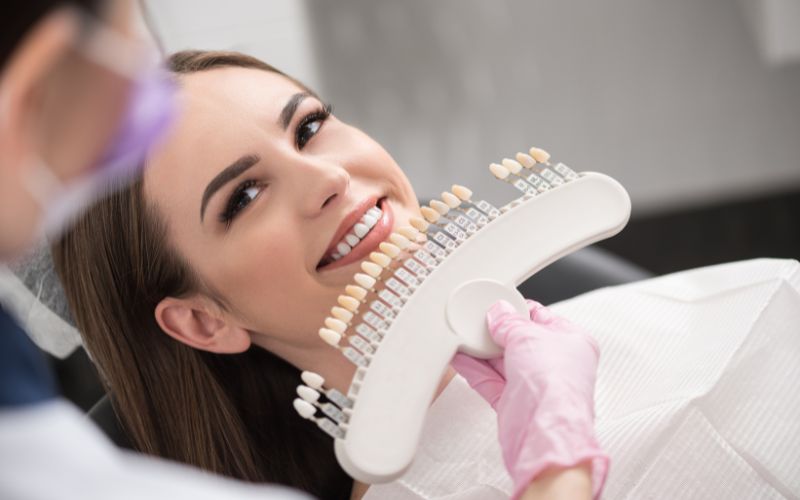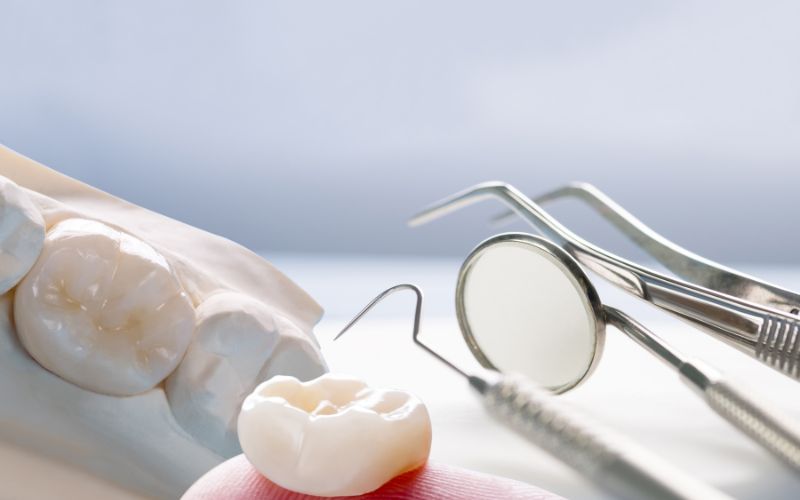Dental crowns are versatile restorations. They strengthen and support damaged and decayed teeth, and are used as prosthetics to replace missing teeth. They are also used cosmetically to cover a discoloured or misshapen tooth.
If you’ve ever wondered how they are made, so they look natural and fit a tooth perfectly, read on!
Table of Contents
ToggleTypes of Crowns
A crown can be made from a variety of materials. Different materials are chosen to meet the needs of the patient and the forces the tooth will face. In the past, metal t crowns were often chosen for back molars, since they faced greater pressures and aren’t very visible. Porcelain-fused-to metal crowns have the durability of metal, but look more aesthetic, and may be used for a molar, however. With recent improvements of technology zirconia and emax crowns are often preferred teeth, as they are tooth coloured materials.
A same day crown is one that is digitally planned and designed using computer-aided design/computer-aided manufacturing (CAD/CAM) equipment. Usually, this process is for zirconia dental crowns. They can be placed in the same visit which means that there is no need for a temporary crown and a return visit.
Making a Dental Crown
Impression
The tooth is prepped, to allow room for the dental crown, at which point an accurate impression is taken. Regardless of the type of crown, this step needs to be done. It can be done digitally with an intraoral camera for a virtual 3D image that allows dentists to examine the teeth on a screen and see how changes would look, or this step can be done with an impression material. Digital imaging tends to be more comfortable, and it gives more accurate results that can also be stored electronically.
Dental Lab Heat Pressed or Baked Dental Crown Procedure
Once the dental lab receives the digital images or impression of the tooth, along with recommendations from the dentist on tooth shape and size, the impression is used to create a mold, or model plaster. This lets the technicians make any necessary changes. A cast is a replica of the entire set of teeth, while a die is a replica of the prepared natural tooth only.
The first impression is also used to create another mold called an investment, which can resist high temperatures when the crown is being baked and the wax melts in the casting furnace.
Next, a wax pattern for the prepared natural tooth is made. This is used as the plan for the crown, to ensure it fits properly. The wax is either hand-painted or immersed into wax by the technician, to create a clean layer. A die spacer is used to mark the space between the crown and the prepared tooth, to ensure the dentist is able to cement the crown.
The technician then marks the pattern. This is a detailed process, and every angle and point needs to be accurately marked, so the crown works and fits properly.
When the wax mold is ready, the technician pours the chosen material in, to then be baked or pressed.
Porcelain Crowns
Porcelain crowns are made with a range of glass ceramics. The materials are solidified into the crown form by baking or pressing, using a special machine.
Layering and Polishing
Layering and polishing is important for the dental crown’s aesthetics. A shade is carefully chosen to match the patient’s surrounding teeth, which is shared with the labs, along with other details to help the technicians with layering.
Layering involves applying a few layers of slightly different colours, to look more like natural teeth. Technicians apply the layers carefully, to improve the match with other teeth and to make the crown look highly realistic, instead of giving the impression of a flat surface. An acrylic polymer is applied, and the crown is polished, to give the final touches.

Same Day Dental Crown Procedures (Digital Imaging and Milled Crowns)
Computer-aided design/computer-aided manufacturing (CAD/CAM) technology enables quick and accurate digital impressions. This also means dentists are able to use the digital images to make changes to create milled crowns in-office, through computer aided manufacturing.
Once the images are taken, CEREC (Chairside Economical Restoration of Esthetic Ceramics) technology provides the dentist with computer assisted design tools to fit and shape the new crown, so a dental crown can easily be planned and designed digitally.
The plans are communicated to a special, automatic milling machine, which recreates the crown form using computer aided manufacturing technology. The machine uses a block of crown material, and grinds and cuts away material until the desired shape is left.
Crown Placement
The dentist will always make sure the crown fits well, has a good aesthetic appearance, and is comfortable before using dental cement to secure the dental crown.
For expert dental crowns in Erin Mills, call Onyx Dental at (905) 567-4999. Visit us at 2555 Erin Centre Blvd Unit 12, L5M 5H1 for comprehensive dental crown services tailored to your needs, whether for strengthening, protecting, or enhancing your smile.



